Best canals in Amsterdam
What are the best canals in Amsterdam?
So, you’re visiting Amsterdam and wondering what are the prettiest and most famous canals in Amsterdam. Ask ten locals about the best canals and you will probably get ten different answers. Then who should you trust?
Well, how about someone who has been living and boating in Amsterdam for over 25 years and has operated his own Amsterdam boat rental company for 15 years? That someone is me. I’m sure you’ll appreciate my list of the most beautiful and most famous canals in Amsterdam. Here we go:
Read below to find out what makes each of these canals so special!
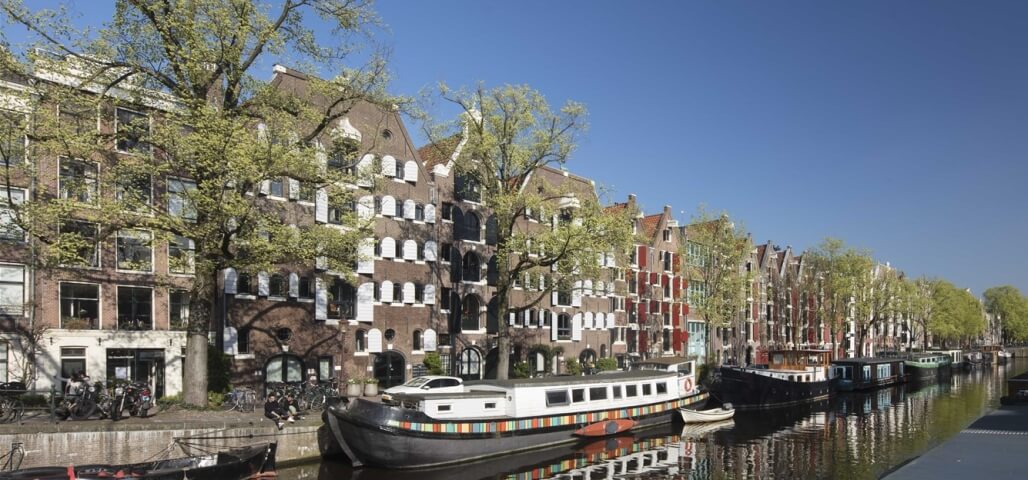
1. Brouwersgracht: it all started with beer…
Many Amsterdam locals will agree that the Brouwersgracht is the most beautiful canal of Amsterdam. In 2007, when local newspaper ‘Het Parool’ asked its readers to vote for the most beautiful street of Amsterdam, Brouwersgracht actually ended top of the list.
What is it that makes Brouwersgracht the most beautiful canal?
It’s probably a combination of things:
* the beautifully preserved canal houses;
* the presence of many attractive house boats on both sides of the canal;
* the rather small streets bordering the canal with relatively little motorised traffic;
* the majestic trees scattered along the canal;
* the nice bridges decorated with flowers and Dutch biked locked to them;
* the wide and picturesque views at the intersections with the four main canals.
All that ain’t bad for a former ‘industrial area’, right? Because that’s what Brouwersgracht (literally translated: Brewery Canal) was in the old days: a canal full of beer breweries. Many of the warehouses that you still find on Brouwersgracht were used to store the grains. We’re talking late 16th century, when regular water was too polluted to drink. So believe it or not: beer was always the best drink to go for.
Nowadays, Brouwersgracht belongs to the most popular residential areas in town. The prices of real estate have skyrocketed over the last couple of years. This includes the house boats, of which many are for rent on Airbnb and other holiday home portals. In between all residential apartments are some specialty shops, small scale offices, and a couple of iconic cafes. They include all time local favourites such as café Thijssen (on the corner of Brouwersgracht and Lindengracht) and café Papeneiland (since 1642, on the corner of Brouwersgracht and Prinsengracht).
Moreover, Brouwersgracht combines beauty with function. It connects the four main canals in town (Singel, Herengracht, Keizersgracht and Prinsengracht) and it is one of the main arteries for boats heading into Amsterdam’s Wild Wild West. Surprisingly, despite its attractiveness and its function as a corridor, the more western part of Brouwersgracht (west of the intersection with Prinsengracht) is still relatively quiet.
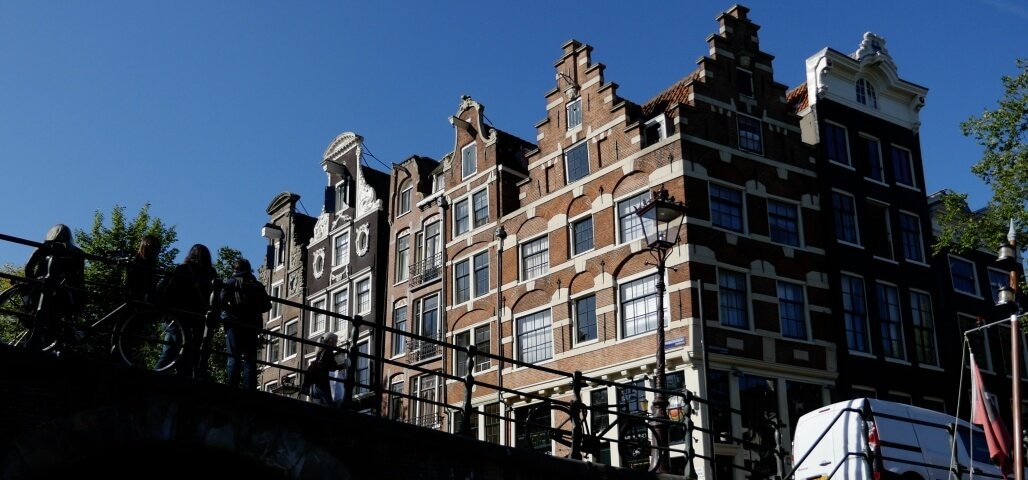
2. Prinsengracht: maybe not the most beautiful, but definitely the most famous canal in Amsterdam
If we were to make a list of the most famous canals in Amsterdam, without any doubt Prinsengracht would rank number 1. I guess that 99% of all Amsterdam visitors get to see Prinsengracht, one way or the other. And so should you!
With its impressive length of more than 3 kilometers this famous canal cuts right through the city center, starting in the northwest at Brouwersgracht and ending in the Amstel river. One could argue that the extensions Korte (meaning ‘short’) Prinsengracht to the north and Nieuwe (meaning ‘new’) Prinsengracht to the east are also part of Prinsengracht, making it even more omnipresent.
The construction of Prinsengracht started in1612 and took almost 50 years to complete. In that period Amsterdam became the third largest city in the world, after London and Paris. Can you imagine?
After all this time Prinsengracht is still bustling with life, mainly due to a perfect blend of different functions. Prinsengracht is a thriving village in itself: there are residential apartments, hotels, offices, shops, galleries, cafes, restaurants, churches, coffee shops, museums and so on. Among these are two Amsterdam icons: the Westerkerk (church) and Anne Frank’s House.
The magnificent Westerkerk is a 17th century protestant church in renaissance style. Its 87 meter tower is a true Amsterdam landmark and contains a lot of ‘bling bling’, with a golden clock that produces beautiful reflections just before sun set and majestic crown on top. A pretty well kept secret is a guided climb of the tower, only by reservation at fixed times, for a breath-taking view of the Jordaan area and the rest of the city.
Right next to the Westerkerk is Anne Frank’s House. Here you can visit the place where Jewish teenage girl Anne Frank hid from the Germans and wrote her diary before she was betrayed and transported to Germany to die in Bergen-Belsen shortly before the end of WW II. This sad and impressive memorial of the Holocaust is one of Amsterdam most frequently visited sites. Make sure to buy your ticket online if you want to visit it.
In the actual canal of Prinsengracht you will get to see many house boats, ranging from very luxurious and modern to some rather original but run down ones. You might be able to get a glimpse of the interiors while passing them on your boat tour. But if you want to have a proper look in a real houseboat, either rent a houseboat during for your stay or -a lot more economic- visit the houseboat museum on Prinsengracht.
A boat trip on Prinsengracht used to be rather chaotic on peak days. Recently, with the introduction of one way traffic this has changed. Although still popular and very busy at times, boat traffic on Prinsengracht has become rather orderly and easy. You just go with the flow. Please make sure to go the right way, from the north towards the Amstel river. Ghost riding could be painful in many ways, including a fine of euro 340,-.
Three times a year chaos returns on Prinsengracht. It is the most popular and most congested canal during King’s Day (27 April), with parties everywhere, both on the shore and on boats. Prinsengracht is also the longest part of the annual canal parade during Gay Pride (first Saturday of August), attracting an enormous crowd to see the 80 large decorated party boats full of people dancing, singing and celebrating diversity, freedom and respect. And it is home to the annual Prinsengrachtconcert, when after sun set part of the Prinsengracht is turned into a large open air venue for a free classical concert in a magical atmosphere.
Scroll down for the most beautiful canals, numbers 3 to 7.
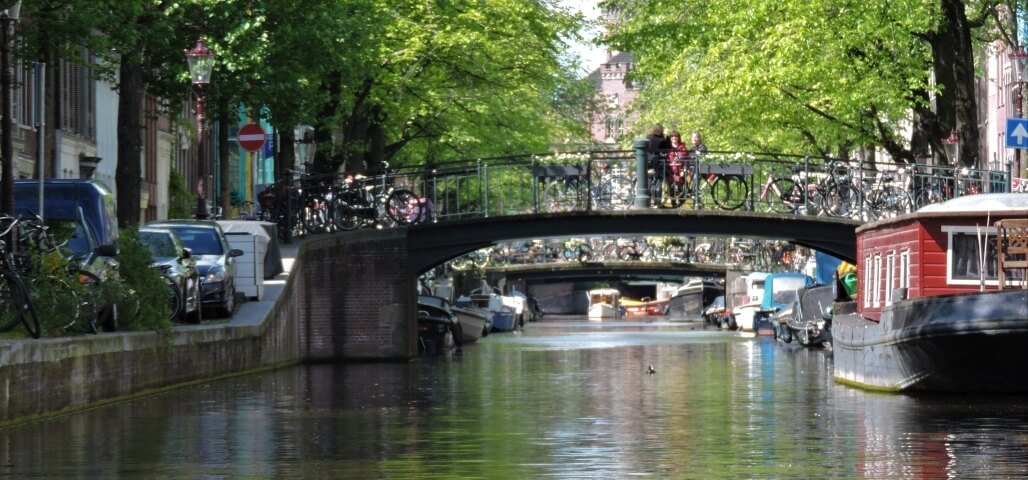
3. Bloemgracht: from wallflower to sunflower
Bordering Prinsengracht at the western side is the popular Jordaan area. This densely populated area consists of a couple of dozen streets and a handful of canals. All of these look like miniature versions of the four main canals. In general the Jordaan canals are narrower, the houses along them smaller and the bridges more slender. Altogether this gives the Jordaan a very intimate and small scale atmosphere. Just like the main canals, the Jordaan has a nice mixture of residential homes, small scale offices, one of a kind shops, galleries, hotels, restaurants and cafes.
Whereas in the 17th century the main canals were home to the rich and famous of the city (which has not changed since then), the Jordaan was the low cost alternative. This showed in the poor quality of the housing, which attracted many immigrants. Among them were many French protestant refugees. Some say the word Jordaan is derived from ‘jardin’, the French word for garden. That explains the many streets named after flowers.
The Jordaan is the earliest example of the gentrification process that is still expanding, nowadays even in the more remote parts of Amsterdam. Ever since its development the Jordaan housed poor families with many children on a very small surface. During a large period of time the Jordaan was even considered a sort of ghetto. Only as recently as in the 1980’s and 1990’s both government, housing associations and private parties severely increased their investments in this area, and its hidden potential appeared quickly and clearly. Nowadays, the Jordaan is an extremely popular and expensive area to live in.
Despite their beauty and their central location most of the time the Jordaan canals are relatively quiet. This makes them an excellent area to discover yourself on a self-driven rental boat. You can’t go wrong taking any of the Jordaan canals: Egelantiersgracht, Bloemgracht, Lauriergracht, Looiersgracht and Passeerdersgracht.
Actually it is nice to see at least two: one of them from Prinsengracht to Lijnbaansgracht and another one back from Lijnbaansgracht to Prinsengracht.
Last but not least, there’s one question still open: what canal is the most beautiful canal of the Jordaan area? I’m going for Bloemgracht (translated: Flower Canal), starting closely to the Westerkerk with an interesting mixture of large and small houses and a couple of nicely flower decorated bridges.
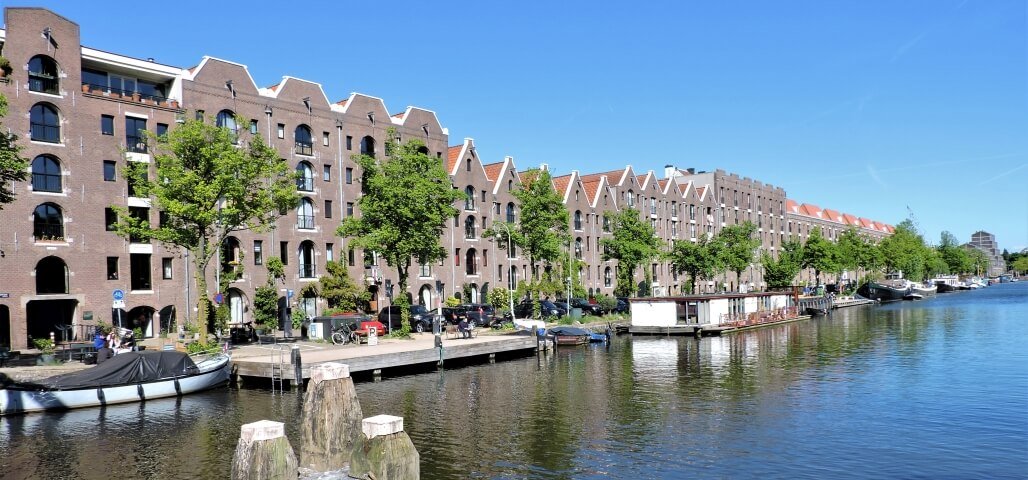
4. Entrepotdok: French storage houses facing African wildlife
I’m sure that Entrepotdok is not on everyone’s shortlist of prettiest Amsterdam canals, but this eastern city center canal has been a personal favourite of mine since I arrived in Amsterdam in 1993. Back then it was still of the beaten track. Nowadays, that would be too much to say, but it is still not as frequently visited as many of the more centrally located canals.
Some might argue that Entrepotdok lacks the variation in architecture that many other canals have, but for me this is also what makes it stand out. It’s the similarity in this long straight row of former warehouses that impresses.
Presently, the spacious apartments in these buildings are highly wanted (and therefore sad enough still too expensive for me), but in the early 19th century they were built for a different purpose: storing goods from all over the world. Think of products that we still use (like wine, cocoa, grain, rye and wood), but also goods that have fortunately gone ‘out of fashion’ like whale bacon and whale tear.
The name Entrepotdok still reminds of its function. Entrepot is French for a customs-controlled warehouse. The French rulers at that time decided that all imported goods had to be checked and taxed at one central storage point, before they were further distributed. So ‘merci beaucoup’ to the French for the pretty looks of this canal!
The other (southern) side of the canal could not look (and smell) more different: it’s the Artis Zoo. Here you might be able to spot some wildlife (like zebras and giraffes), to add some ‘safari flavour’ to your Amsterdam canal trip.
Scroll down for the most beautiful canals, numbers 5 to 7.
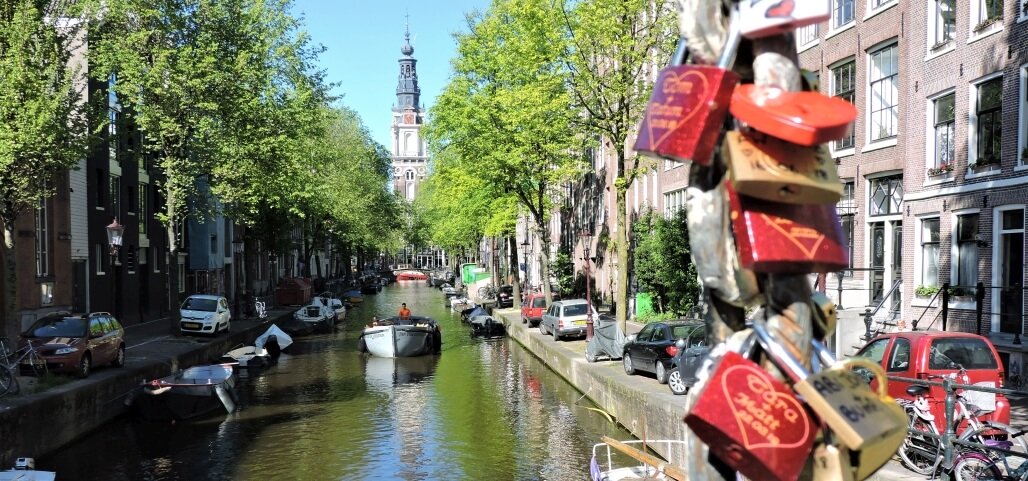
5. Groenburgwal: hidden, green and famous for an awkward reason
The Groenburgwal is a real hidden gem right in the centre of Amsterdam. It is a direct side canal of the Amstel river. It is rather short, quite narrow and the southern entrance is via a very charming but rather low wooden drawbridge. Because of these restrictions, you won’t find any large (tour) boats in this pretty canal. Coming from the south you will get a lovely view on the canal, with the good-looking Zuiderkerk (‘southern church’) on the background as a bonus.
In the old days this canal housed a lot of cloth weaving factories and the ‘groen’ (meaning ‘green’) in the name of this canal came from the presence of dye houses specialised in the colour green. At present, the colour green is still abundant: many lush trees give this canal a very green appearance and also a lot of shade.
Many Amsterdam locals might also remember Groenburgwal for another reason. There used to be a well-known public health clinic for STD’s. I’m afraid the author of this article has also been here. Just once, of course. And yes, everything is fine now, thanks for asking.
Groenburgwal is also a populair hangout for couples in love. Many of them attach a lock with their names on it on the nice old bridge. Because of that ritual this bridge has become a battle ground between the free market economy and local government regulators. The nearby shops keep on selling locks, whereas city hall makes sure that all locks are regularly removed from the bridge.
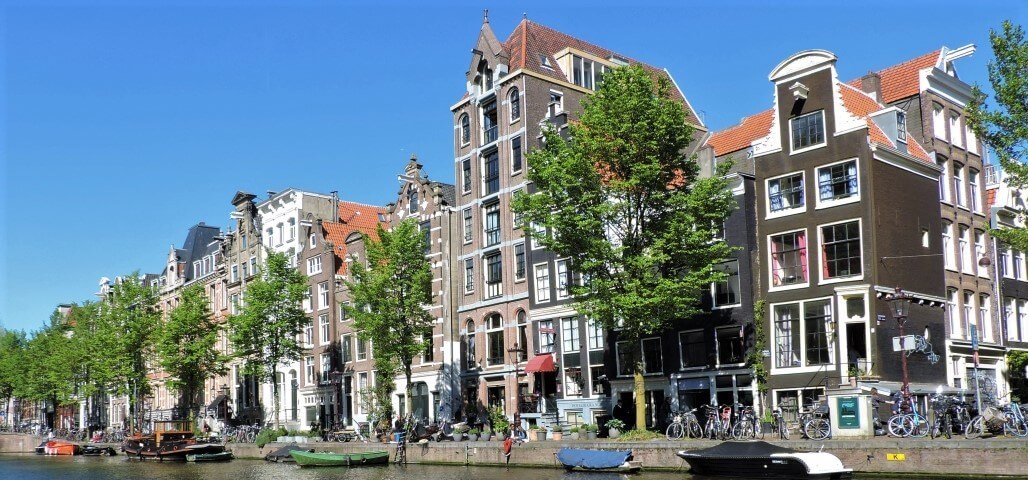
6. Herengracht: this famous canal rules the city
Herengracht is one of the four main canals in Amsterdam and widely considered to be the one of the prettiest canals and definitely the most prestigious. Top of the bill is the so called ‘Gouden Bocht’ (translated: ‘golden bend’). This is where the top class regents and rich merchants ruling the Dutch Republic in the 17th century built their impressive houses. Think of the Elon Musk, Bill Gates and Jeff Bezos of that era, having made their fortune in worldwide trading.
Currently, the most notable regent living on Herengracht is the mayor of Amsterdam on number 502. Her name is Femke Halsema, the first ever female mayor of Amsterdam and also the first Amsterdam mayor that comes from Groen Links (the Green Party).
In this particular stretch of Herengracht most plots of land -and as a result also the facades of the houses- are double the regular size. Apart from the remaining residents Herengracht has become a favoured habitat for any type of office that can afford marble staircases, decorated high ceilings and antique chandeliers.
It is really easy to include the beautiful Herengracht in a boat tour. Unfortunately, a boat tour on Herengracht does not reveal what is -let alone what was- behind the facades of these houses. If you want to know, it’s worthwhile to check out Museum Willet-Holthuysen on Herengracht 605. It has an authentic 18th and 19th century interior and a beautiful garden. Or go to Het Grachtenhuis (translated: ‘the Canal House’) on Herengracht 386 for literally everything you might want to know (and much more) about the Amsterdam canals.
A final more peculiar museum is the Kattenkabinet (translated: the Cat Cabinet), a small scale private art museum with ‘cat art’. This museum was founded by local Bob Meijer in remembrance of his cat named ‘John Pierpont Morgan’. I’m honestly not making this up! Reality sometimes beats imagination…

7. Reguliersgracht: ‘postcard Amsterdam’
Another perfect place for a ‘postcard picture’ of Amsterdam is the relatively narrow Reguliersgracht. Just like Brouwersgracht, this is a canal that connects the main canals. From north to south it intersects with Herengracht, Keizersgracht, Prinsengracht and Lijnbaansgracht. Unlike most Amsterdam canals Reguliersgracht follows a straight line. This allows for a unique perspective of seven similar bridges in a row.
Almost all canal tours include the beautiful Reguliersgracht. From Herengracht you will get a nice view on it. It seems impossible to pass along Reguliersgracht without taking a short break for a picture. The boat in front of you will definitely remind you of that.
Near the intersection of Reguliersgracht and Prinsengracht is Amstelveld, a rather tranquil and spacious square that you might not expect in the middle of town. The beating heart of this area is Café Nel, a 17th century wooden church transformed into a brasserie with a large outdoor terrace, impressive trees and a playground.
